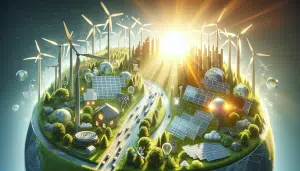Why You See So Many Wildfires in the News
Lily Carter September 29, 2025
Curious about the surge in wildfire headlines? This in-depth guide explains why wildfires appear so frequently in the news, explores their environmental impact, the challenges of reporting them, and how real-time coverage shapes public perception. Learn what drives wildfire news cycles and how they affect you.
Wildfires and Their Rise in Headlines
There’s little escaping wildfire news these days. Major outlets report on wildfires more often than ever. What’s changed? Extreme weather events have become both more relentless and more newsworthy, and wildfires stand out among them. Scientists point to hotter, longer summers and persistent droughts increasing the scale and frequency of fires, which make for dramatic stories and often eye-catching visuals. Journalists and editors know that readers and viewers are drawn to stories with an immediate sense of impact and danger, so wildfires often lead newscasts or dominate online coverage. Increased global awareness has made news cycles more sensitive to environmental threats, so even small wildfires in remote areas find their way into the spotlight as a result of collective anxiety about climate change and natural disasters (https://www.nasa.gov/feature/goddard/2020/wildfires-increasing-in-intensity-and-frequency).
Why this flood of attention now? Social trends help explain it. Visual media—including footage from satellites, firefighters’ helmet cams, and drones—make wildfires highly accessible to the public. Newsrooms increasingly rely upon real-time images and live reporting from affected areas. There’s a certain immediacy that accompanies wildfire coverage, drawing viewers in with tense updates and dramatic evacuations. News aggregators and social sharing platforms multiply the effect, as wildfire headlines and hashtags trend across multiple platforms. This attention cycle isn’t likely to disappear. In fact, as wildfires continue to affect communities, forests, and infrastructure, their presence in the news may even grow.
It’s not just TV news. Print and online journalism invest heavily in wildfire coverage for another key reason: people care because these natural disasters are both local and global. Community disruptions, home losses, and long-term environmental scars are part of the public discourse. Wildfires capture an ongoing struggle between urgent response and broader policy debates about land management, resource allocation, and disaster recovery. With all of these forces at play, it’s no wonder that wildfire stories frequently dominate major news sites and regional broadcasts alike (https://www.bbc.com/news/world-59514598).
The Science Behind Wildfire Frequency
The steady stream of wildfire news is grounded in real scientific shifts. Studies show that fire seasons are both starting earlier and lasting longer in many regions. Atmospheric scientists point to a mix of rising global temperatures, changing precipitation patterns, and increased fuel loads as critical drivers behind recent wildfire trends. Drier conditions allow forests and grasslands to accumulate flammable debris. Lightning and human activities, including campfires and discarded cigarettes, provide the necessary sparks. Together, these conditions lead to more fires—and more severe fires—which spell trouble for both communities and ecosystems (https://www.fs.usda.gov/science-technology/fire).
Wildfire risk isn’t evenly distributed. Certain landscapes, like Mediterranean-type forests or arid shrublands, are especially prone to burning. Weather conditions such as high winds and low humidity can quickly escalate a manageable fire into a major catastrophe. Fire management experts track these trends in order to prepare for both planned burns and emergency responses. The science is clear: as the world warms and land use changes continue, news organizations have more frequent disasters to report. These trends, confirmed by global monitoring agencies, help explain the ongoing flood of wildfire coverage—and remind us that vigilance is justified.
Researchers emphasize that while wildfires are a natural part of many ecosystems, today’s fires are often more intense, more unpredictable, and more likely to threaten populated areas. Urban development in former wilderness zones creates what is called the “wildland-urban interface”—a place where flames and homes meet. Science-driven journalism brings context to these stories, explaining why old assumptions about fire frequency no longer hold. The deeper the public understanding of fire science, the more meaningful wildfire coverage can become (https://climate.nasa.gov/news/3123/the-science-of-wildfires/).
How News Outlets Report Wildfires
Wildfire reporting has evolved with technology. In the past, local media might have been first to alert residents about evacuation orders or air quality advisories. Now, satellite imagery and GIS apps share real-time updates directly with the public—and reporters. Journalists rely on official briefings but increasingly supplement coverage with eyewitness video, agency social media feeds, and rapid-response expert interviews. As a result, wildfire news is more immediate and often more personal. Media outlets highlight on-the-ground voices—firefighters, emergency responders, and residents—giving urgent human context to technical details and satellite maps.
Accuracy is a challenge in crisis reporting. Wildfires can change direction in minutes, rendering early news updates outdated as soon as they’re published. Editors must sort reliable sources from rumor or speculation, especially when stories are amplified through social media. Many outlets now partner with trusted agencies such as the U.S. Forest Service or local emergency management to verify details before publishing. Channels devoted to environmental and science news help readers make sense of the hazards and solutions, offering educational resources around wildfire preparation, recovery, and resilience (https://www.efsa.europa.eu/en/news/understanding-wildfires-what-weve-learnt).
Wildfire stories pose unique logistical hurdles for news teams. Flames and smoke can threaten journalists in the field, while power outages and closed roads disrupt communications. News organizations prioritize safety, but there’s growing interest in training media workers to report safely—similar to protocols used in war or disaster zones. Meanwhile, digital platforms help keep coverage going when traditional infrastructure is compromised. By blending up-to-the-minute facts with local experience, wildfire journalism seeks to inform without inciting panic. Stories that balance impact with empathy often resonate most with audiences.
Environmental and Social Impact of Wildfires
Wildfires affect far more than trees. News coverage draws attention to their broad environmental impact—on air quality, drinking water, wildlife, and even local economies. Airborne particles from burning forests can travel hundreds of miles, creating hazardous air for people with asthma or respiratory conditions. Ash and debris often contaminate waterways and reservoirs. Local species may lose critical habitat, while recovering landscapes take years to regrow. These ripple effects make wildfires a year-round news topic, not just a seasonal headline (https://www.epa.gov/wildfire-smoke-course/health-effects-wildfire-smoke).
Social disruptions linked to wildfires frequently appear in reporting. Mass evacuations, property losses, and health challenges create major challenges for affected communities. Insurance coverage can be a major point of discussion, as many are uninsured or underinsured for extreme fire events. Governments sometimes step in with emergency aid or temporary housing assistance, but the recovery process can be long and uneven. News stories focus on local heroes, grassroots responses, and debates over preparedness and prevention. These narratives keep wildfire coverage personal and relevant, reminding audiences why the topic matters.
Each wildfire leaves a lasting legacy, often shaping community identity and future news cycles. Survivors share their experiences long after the flames die down. Lawmakers debate land management and insurance reform. Health researchers track ongoing impacts of smoke exposure. Journalists revisit affected communities, following the rebuilding process or spotlighting ongoing risk as another fire season approaches. The environmental and social footprint of wildfires gives journalists a continuous source of timely, meaningful stories—and encourages the public to stay informed year-round.
Why Wildfire News Shapes Public Perception
There’s a powerful feedback loop between wildfire reporting and public awareness. The more visible wildfire coverage becomes, the more people adjust their expectations of risk, insurance, and safety. Research shows that repeated disaster news can heighten anxiety yet also drive preparedness and community response. Public service announcements and safety campaigns often rely on dramatic wildfire imagery to encourage action. The prominence of these stories has helped wildfire risk become widely recognized, prompting policy discussions at every level—from homeowners’ associations to international climate summits (https://www.redcross.org/about-us/news-and-events/news/2022/wildfires-impact-communities-and-response.html).
Not all impacts of wildfire news are positive. Viewers exposed to constant disaster coverage may experience fatigue or tune out entirely, a phenomenon sometimes called “compassion fatigue.” Others may feel overwhelmed by the alarming headlines but find little guidance on practical steps to reduce risk. Media organizations have tried to address this by publishing more solutions-focused stories—exploring proactive strategies for preparation, recovery, and mental health support as part of their wildfire coverage. Such stories can demystify fire response and help viewers feel empowered, not just alarmed.
Public perception also affects policy. When media consistently highlight wildfire damage, there’s greater political will to fund prevention, support research, or overhaul land management. Journalists therefore act as mediators between public experience and legislative action. As long as wildfires remain a regular news feature, they are likely to spark changes across everything from home design standards to resource deployment. Public engagement—driven by consistent, responsible news practices—plays a key role in developing a safer, more resilient approach to fire threats.
The Future of Wildfire Reporting
With wildfires predicted to remain a fixture in the news cycle, how will reporting evolve? Emerging technologies offer new tools for coverage. Artificial intelligence, remote sensing, and predictive analytics help news teams offer timely warnings and context before crises escalate. Reporters increasingly collaborate with researchers, policymakers, and disaster-response organizations to provide in-depth, solutions-oriented stories. Community-powered platforms and crowdsourced reporting supplement official updates, providing more nuanced accounts of risk and recovery as events unfold. Expect wildfire news to keep evolving in step with advances in climate science and communications technology (https://www.noaa.gov/news-release/new-tool-predicts-wildfire-spread).
This shift toward more interactive, audience-driven news can help empower people to prepare for fire seasons and participate in their own safety. Data dashboards and real-time alerts keep community members informed, while explanatory journalism breaks down complicated science into actionable insights. The most effective wildfire reporting doesn’t simply document disaster—it explores root causes, highlights resilience, and supports long-term learning and adaptation. This broader approach reflects a growing understanding that wildfires are both an environmental challenge and a societal one.
In the end, wildfire reporting will remain both challenging and vital. The stakes are high, and the pace is fast. By blending innovative reporting with public education, news organizations play a key role in shaping response, recovery, and prevention. Staying informed is not just wise—it’s essential for adapting to our changing world. This is why wildfire headlines keep returning, season after season, across all your favorite news platforms.
References
1. NASA. (2020). Wildfires Increasing in Intensity and Frequency. Retrieved from https://www.nasa.gov/feature/goddard/2020/wildfires-increasing-in-intensity-and-frequency
2. BBC News. (2021). Why Are There So Many Wildfires? Retrieved from https://www.bbc.com/news/world-59514598
3. U.S. Forest Service. (n.d.). Fire Science. Retrieved from https://www.fs.usda.gov/science-technology/fire
4. NASA Climate. (n.d.). The Science of Wildfires. Retrieved from https://climate.nasa.gov/news/3123/the-science-of-wildfires/
5. European Food Safety Authority. (2022). Understanding Wildfires. Retrieved from https://www.efsa.europa.eu/en/news/understanding-wildfires-what-weve-learnt
6. U.S. Environmental Protection Agency. (n.d.). Health Effects of Wildfire Smoke. Retrieved from https://www.epa.gov/wildfire-smoke-course/health-effects-wildfire-smoke







